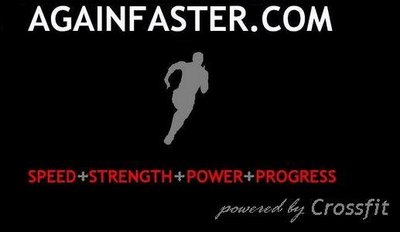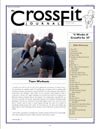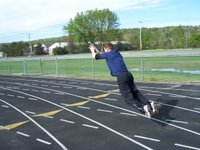Impulse Control

Virtually all athletic activities involve maximal force development. This may be directed toward starting, stopping, changing direction, or maintaining a vector at top speed. Likewise, it may be directed at throwing, jumping, and hitting. As a general rule, the more force you’re able to develop, the greater your athletic potential.
The fastest sprinter and highest jumper direct the most force toward the ground with the greatest speed, as does the world record holder in the clean and jerk. Each one of these athletes depends on their ability to move a motionless object into motion.
For the track athlete, this object is themselves, while the weightlifter is moving a barbell. For the aspiring Crossfitter, this object could be themselves, a rower handle, a barbell, a kettlebell, a medicine ball, or any other form of resistance. In each instance, we’re looking to move an object from rest to top speed in the shortest amount of time possible.
Moving an object from rest (or in a new direction) requires an impulse. This quantity is equal to the average force applied to an object multiplied by the duration of that force application.
Impulse = Force (avg.) * duration of force application
The greater the overall impulse, the faster the ensuing acceleration will be, all other things being equal. Therefore, to maximize our sprint start, our first pull, and our rowing stroke, we must maximize impulse.
There are two ways to maximize impulse—increase force or increase the duration of force application. Ideally, we won’t separate these quantities. We’ll generate a ton of force for as long as possible.
Maximizing force is intuitively obvious. We want to push hard and fast. Even beginning athletes know that “harder and faster” increases force output. Tell a little leaguer to hit a baseball as hard as he can, and the little guy will swing the bat as fast as he can.
The problem comes when we automatically associate the speed of an action with its force potential. If you were trying to knock out Chuck “The Iceman” Liddell, you would try to hit him as hard as possible as quickly as possible, but you wouldn’t rabbit punch the guy fifteen times. Intuitively, you know that one strike delivered well is more effective that ten strikes delivered poorly, even if both efforts take the same amount of time.
I constantly observe Crossfit athletes trying to “knock out the Iceman” by going too fast. They attempt to speed up their sprinting by increasing stride frequency, speed up their rowing by increasing stroke rate, and clean more weight by pulling on the bar “faster”.
It doesn’t work.
These athletes are sacrificing impulse generation for speed. By blindly pursuing “faster”, they are maximizing force but inadvertently minimizing the duration of force application. Their feet don’t stay in contact with the ground or the rower pedals long enough to generate a meaningful impulse. As our handy-dandy equation shows, maximal force means nothing if the duration of force application approaches zero.
When accelerating an object—self, barbell, rower handle—the athlete must consciously strive for a maximal period of force application. In practice, this means staying in contact with the ground or the foot pedals for as long as possible while applying maximal force. Rather than row “faster”, we need our athletes to row “harder”.
The same principle applies to sprinting. Those who come out of the blocks the fastest generate the largest impulse. They maximize ground contact time for the first twenty meters of a race, pushing “harder” than the competition. Similarly, our Olympic lifters attempt to keep their feet flat on the platform for as long as possible, maximizing contact time and therefore maximizing the impulse to the barbell. Each reaps the benefit of greater acceleration.
Graphically, impulse generation is a parabolic function. For each athlete, there will be a moment of perfect balance between force generation and duration of force application. After this point, force generation drops.

For each athlete, we must find the point where the amount of force and duration of application result in the greatest impulse. Fortunately for the coach and the individual athlete, most athletes are on the early side of the curve, where duration is insufficient to maximize impulse.
Next time you’re going for that personal record, remember to push harder longer. Contact time is essential. You don’t want the Iceman to realize you’re trying to knock him out.
Go faster!
Picture of Chuck Liddell courtesy of plu.edu. "The Iceman" is a Crossfitter, training under John Hackleman at The Pit. Given his recent victory over Tito Ortiz, it must be working!

Virtually all athletic activities involve maximal force development. This may be directed toward starting, stopping, changing direction, or maintaining a vector at top speed. Likewise, it may be directed at throwing, jumping, and hitting. As a general rule, the more force you’re able to develop, the greater your athletic potential.
The fastest sprinter and highest jumper direct the most force toward the ground with the greatest speed, as does the world record holder in the clean and jerk. Each one of these athletes depends on their ability to move a motionless object into motion.
For the track athlete, this object is themselves, while the weightlifter is moving a barbell. For the aspiring Crossfitter, this object could be themselves, a rower handle, a barbell, a kettlebell, a medicine ball, or any other form of resistance. In each instance, we’re looking to move an object from rest to top speed in the shortest amount of time possible.
Moving an object from rest (or in a new direction) requires an impulse. This quantity is equal to the average force applied to an object multiplied by the duration of that force application.
Impulse = Force (avg.) * duration of force application
The greater the overall impulse, the faster the ensuing acceleration will be, all other things being equal. Therefore, to maximize our sprint start, our first pull, and our rowing stroke, we must maximize impulse.
There are two ways to maximize impulse—increase force or increase the duration of force application. Ideally, we won’t separate these quantities. We’ll generate a ton of force for as long as possible.
Maximizing force is intuitively obvious. We want to push hard and fast. Even beginning athletes know that “harder and faster” increases force output. Tell a little leaguer to hit a baseball as hard as he can, and the little guy will swing the bat as fast as he can.
The problem comes when we automatically associate the speed of an action with its force potential. If you were trying to knock out Chuck “The Iceman” Liddell, you would try to hit him as hard as possible as quickly as possible, but you wouldn’t rabbit punch the guy fifteen times. Intuitively, you know that one strike delivered well is more effective that ten strikes delivered poorly, even if both efforts take the same amount of time.
I constantly observe Crossfit athletes trying to “knock out the Iceman” by going too fast. They attempt to speed up their sprinting by increasing stride frequency, speed up their rowing by increasing stroke rate, and clean more weight by pulling on the bar “faster”.
It doesn’t work.
These athletes are sacrificing impulse generation for speed. By blindly pursuing “faster”, they are maximizing force but inadvertently minimizing the duration of force application. Their feet don’t stay in contact with the ground or the rower pedals long enough to generate a meaningful impulse. As our handy-dandy equation shows, maximal force means nothing if the duration of force application approaches zero.
When accelerating an object—self, barbell, rower handle—the athlete must consciously strive for a maximal period of force application. In practice, this means staying in contact with the ground or the foot pedals for as long as possible while applying maximal force. Rather than row “faster”, we need our athletes to row “harder”.
The same principle applies to sprinting. Those who come out of the blocks the fastest generate the largest impulse. They maximize ground contact time for the first twenty meters of a race, pushing “harder” than the competition. Similarly, our Olympic lifters attempt to keep their feet flat on the platform for as long as possible, maximizing contact time and therefore maximizing the impulse to the barbell. Each reaps the benefit of greater acceleration.
Graphically, impulse generation is a parabolic function. For each athlete, there will be a moment of perfect balance between force generation and duration of force application. After this point, force generation drops.

For each athlete, we must find the point where the amount of force and duration of application result in the greatest impulse. Fortunately for the coach and the individual athlete, most athletes are on the early side of the curve, where duration is insufficient to maximize impulse.
Next time you’re going for that personal record, remember to push harder longer. Contact time is essential. You don’t want the Iceman to realize you’re trying to knock him out.
Go faster!
Picture of Chuck Liddell courtesy of plu.edu. "The Iceman" is a Crossfitter, training under John Hackleman at The Pit. Given his recent victory over Tito Ortiz, it must be working!




















5 Comments:
This is an insightful and well-thought out article. I've always thought that good form trumps crappy quantity, but when I read this, a bulb was lit. This articulates exactly what I need to do to adjust my training regimen. Thanks.
Choizilla
I'm glad you found the article helpful, Mike! Keep climbing hard, and let me know if I can ever do anything for you.
By the way, you called "impulse" my concept in your latest blog entry, which it's not. Unfortunately, that distinction belongs to Sir Isaac Newton :)
Best,
Jon
Best,
Jon
Ah, noted and corrected along with the correct spelling of your name. It appears I'm a better CFer than blogger... but only slightly so. I appreciate the time you put into Again Faster.
Just to nitpick, impulse is represented with the delta dirac function, not a second order polynomial. Nevertheless, your point was well made and I enjoy reading the comments on your site.
Good point. I had trouble presenting delta-t in an understandable manner, so I simplified the equation to suit my purposes.
I think you'll find that the spirit of impulse is preserved.
Thanks so much for the feedback and the support!
Best,
Jon
Post a Comment
<< Home